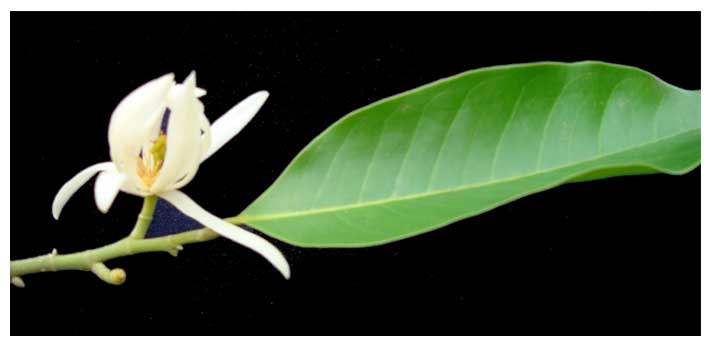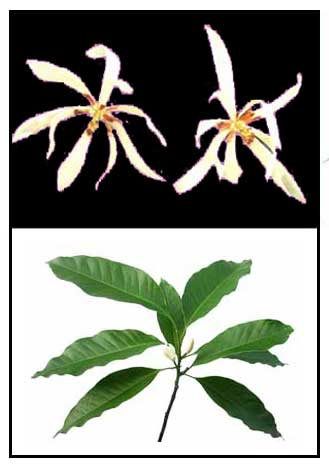| 
Botany
Michelia alba is a small to medium-sized tree, growing
to a height of 4 to 6 meters or more. Leaves are oblong, acuminate, up to 20 centimeters long, glossy green above, pale below. Flowers are white, elongated, bell-shaped, with thin, leathery, and narrow petals, emitting a strong sweet fragrance.
 Distribution Distribution
- Found in towns and cities in the Philippines.
- Ornamental cultivated for its flowers.
Constituents
- Extraction of oil from M. alba by enfleurage method yielded a light yellow oil an aromatic oil with an odor similar to fresh flowers, with indole (1H) (35.5%) as its main composition. Steam distillation yielded a colorless oil with an odor similar to boiled M. alba flowers; its main component was linalool (66.92%). Hexane extraction yielded a transparent oil with a similar but more pungent odor similar to fresh flowers; its major compounds were 2-methyl butanoic acid and linalool (33.01% and 28.92%, respectively). (see study below) (2)
- GC/MS/DS analysis of essential
oil obtained by steam-distillation of flowers yielded 24 constituents: methyl 2-methylbutyrate, camphene, β-pinene, α-phellandrene, β-myrcene, limonene, 1,8-cineole, ocimene, △3-carene, o-cymene, α-cubebene, cis-linalool oxide, α-ylangene, trans-linalool oxide, β-cubebene, linalool, cis-caryophyllene, β-selinerie, δ-cadinene, trans-carveol, methyl, eugenol, β-bisabolene, methyl isoeugenol, isoaristolene. (4)
- Study of flower essential oil for volatile compounds yielded 78 compounds representing 93-98% of overall volatiles identified. Thirty-three of the compounds
were isoprenoids comprising 30-50% to total volatile compounds, the rest were fatty acid derivatives, benzenoid, phenylpropanoid and other hydrocarbon compounds. Major compounds were dihydrocarveol, linalool, butanoic acid-2-methyl, methyl ester and cyclohexane, 1-ethenyl-1-methyl-2,4-bis (1-methylethenyl). (5)
- Study of leaves yielded 21 pure substances, including aporphines, -anonaine, -norushinsunine, -ushinsunine, -N-acetylanonaine, oxoaporphines, liriodenine, oxoxylopine, sesquiterpene lactones, michelenolide, and costunolide. (8)
- Study of leaves yielded ten compounds: (-)-N-Formylanonaine (1), (-)-oliveroline (2), (+)-nornuciferine (3), lysicamine (4), (+)-cyperone (5), (+)-epi-yangambin (6), ficaprenol-10 (7), pheophytin a (8), aristophyll C (9) and michephyll A (10). (11)
Properties
- Bitter, pungent, warm.
- Studies have shown antibacterial, antifungal, antioxidant, tyrosinase inhibiting, anti-asthmatic, cytotoxic properties.
Parts used
Flowers, leaves.
Uses
Folkloric
- Infusion of flowers used as vaginal wash.
- In Chinese medicine, promotes the flow of qi; relieves cough.
- Used for cough, leucorrhea, abdominal distention, prostatitis, sunstroke.
Others
• Rituals / Ornamentals: Flowers are used as religious offerings or used in making garlands. Used for making floral necklaces.
• Aromatherapy: An ideal ingredient for aromatherapy products.
• Perfume: Essential oil used in making highly prized perfume; also used in tea-perfuming.
Used to scent hair oils. Also used for perfuming of clothes in storage. Studies
• Aromatic Oil Extraction: Study reports on the chemical constituents in M. alba flower oil extracted by steam distillation, hexane extraction, and enfleurage method. Study suggests flower oil extracted by enfleurage method, using developed buffalo fats, has a desirable quality of aromatic oil, which should meet the high demands of the aromatherapy market. (see constituents above) (2)
• Extraction of Scents and Essential Oil: Study reports on the extraction of scents and essential oils from M. alba with water, steam, water-steam distillation and cold enfleurage using palm stearin and hot enfleurage using palm oil, hexane and petroleum ether extractions. Yields of essential oil extractions ranged from 0.199 to 0.225%. By GC-MS analysis, linalool was the major component of oils, and indole, linalool, and phenylethyl alcohol were the major component of the absolutes. (3)
• (-)-N-Formylanonaine / Human Tyrosinase Inhibitory / Antioxidant / Leaves: Tyrosinase is the first and rate limiting enzyme in the synthesis of melanin pigments for coloring hair, skin, and eyes. Study isolated a natural product, (-)-N-formylanonaine from the leaves of M. alba. It was shown to inhibit mushroom tyrosinase with IC50 of 74.3 µM, with tyrosinase and melanin reducing activities in human epidermal melanocytes without apparent cytotoxicity to human cells. The compound also showed antioxidant activities on DPPH assay, reducing power and chelation of metal ions. (6)
• Antimicrobial / Essential Oil / Flowers and Leaves: Study evaluated the chemical and biological properties of essential oils in fresh M. alba flowers and leaves. Linalool was the dominant leaf essential oil at 76.6%; other major leaf constituents were farnesol (5.5%), ß-elemene (3.7%) and nerodiol (2.2%). Flower and leaf extracts showed growth inhibition of tested bacteria; the least inhibited was Pseudomonas aeruginosa. Candida albicans was more susceptible to the leaf extract while Fusarium oxysporim was more susceptible to the dichlormethane flower extract. (7)
• Inhibitory Effect on Matrix Metalloproteinases Expression / Application in Preventing Photoaging: UV radiation from the sun can cause skin photoaging by inducing matrix metalloproteinases (MMPs). Study showed Michelia alba inhibited collagenase activity and UVB-induced MMPs. Results showed MA treatment may prevent UVB-induced extracellular matrix damage by inhibiting the expression of MMP-1 and MMP-3. Results suggest potential application in preventing photoaging. (9)
• Antibacterial / Propionibacterium acnes / Essential Oil: Study evaluated the in vitro antibacterial activity of 22 essential oils from Thai medicinal plants against 5 strains of Propionibacterium acnes. Nineteen showed inhibitory activity on P. acnes growth. Michelia alba was one of four that showed strongest antibacterial activity and suggest potential as alternative treatment for acne. (12)
• Cytotoxic Constituents / HeLa Cells / Leaves: Study of methanol extract of leaves of M. alba yielded one new chlorophyll, michephyll A (a novel furanone) and 28 known compounds. (-)-anonaine was the major constituent and showed cytotoxicity against HeLa cells. (14)
• P-Glycoprotein Inhibition / Flowers: Study evaluated flower extracts of four plants, J. sambac, M. siamensis, M. ferre. Michelia alba, and M. elengi for potential influence on metabolism and substance flow in the body. The extracts showed cytotoxicity towards CCRF-CEM leukemia cells in different degrees. Results showed the plants analyzed may be valuable in developing novel treatment strategies to overcome the blood-grain barrier and mutidrug resistance in tumor cells mediated by P-glycoprotein. (15)• Flower Oil by Enfleurage Method: White champaka oil is a fragrant flower with gentle scent. The enfleurage method is believed to yield an aromatic oil closely similar to fresh flowers. GC-MS comparison of oil from various extractions showed the enfleurage method yielded a light yellow oil with similar odor to fresh M. alba flowers and main component of indole III (35.5%). Oil from steam distillation yielded a colorless oil with oder similar to boiled flowers rather than fresh ones, with major component of linalool (66.92%). In perfumery, indole is the natural compound that increases perceived odor strength and improves stability of other aromatic compounds in volatile oils. The M. alba flower oil extracted by enfleurage method, using buffalo fats, has a desirable quality of aromatic oil, which should meet high demands of the aromatherapy market. (16)
• Antiasthmatic: Study on guinea-pig showed that M. alba flowers can antagonize tracheal spasm induced by histamine or acetylcholine, increase perfusion flow and prolong the incubation period of induced asthma and relax asthma symptoms. (17)
• Antifungal / Essential Oil in Vapor Phase: Study evaluated the effect of essential oil vapor on spore germination and mycelium growth of Aspergillus flavus on brown rice and possible extension of shelf life in storage. Results demonstrated good potential of M. alba vapor to control mold growth on the surface of brown rice. (18)
• Trypanocidal Constituents / Bark : An AcOEt extract of bark of M alba exhibited killing activity against Trypanosoma cruzi. Column chromatography yielded eight trypanocidal constituents: caryophyllene oxide (1), costunolide (2), dihydrocostunolide (3), parthenolide (4), dihydroparthenolide (5), 11,13-dehydrolanuginolide (6), santamarine (7), and a new monoterpene (8). The minimum lethal concentrations of the compounds against epimastigotes of T. cruzi were 61 μM, 7 μM, 27 μM, 0.04 μM, 0.78 μM, 0.16 μM, 25 μM, and 5 μM, respectively. (19)
• Cytotoxicity / Anti-Diabetic / Leaves: Study of an ethyl acetate extract and methanol extract of leaves showed toxicity against Artemia salina larvae. Both extracts showed an LD50 at concentration of 100 µg/L. The aqueous extract of leaves showed significant antidiabetic activity using Chinese hamster model. (20)
• Cytotoxicity and Genotoxicity Study / Leaves: Study evaluated the genotoxicity and toxicity of ethnomedicinal Philippine plants i.e., Michelia alba, M. alba, P. cablin, R. communis, C. fistula, R. elliptica, F. elliptica, and G. sepium using Vitotox assay. Dried leaves were used. Results showed the tested medicinal plants were not genotoxic nor cytotoxicm, except for P. cablin and R communis. (21)
• Protective Against UVB-Induced Photodamage: Study investigated the effects of M. alba extract on expression and activity of MMPs in human skin fibroblast cultures after UVB exposure. Results showed MAE treatment may prevent UVB-induced extracellular matrix damage by inhibiting the expression of MMP-1, MMP-3 and MMP-9 through the MAP kinase pathway. Findings suggest potential for an effective agent against UVB-induced photodamage. (22)
Availability
- Cultivated
- Wild-crafted.
- Flowers and seeds in the cybermarket |


![]()

